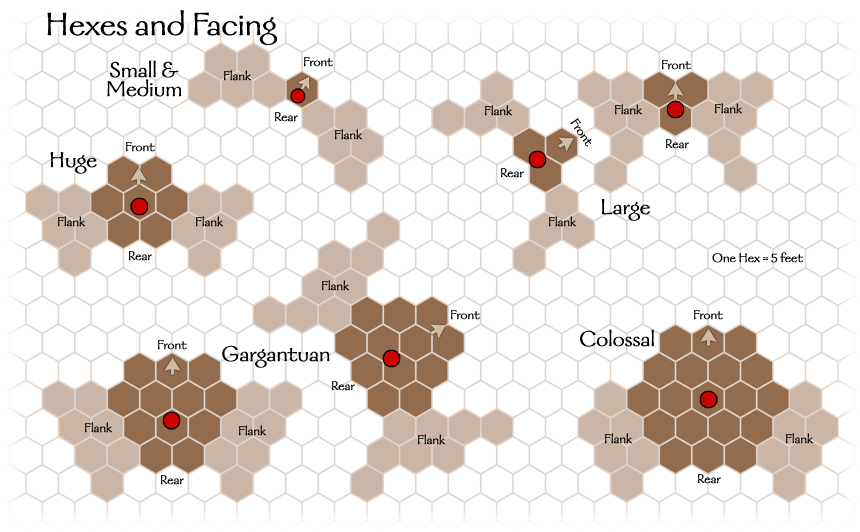Arcanos desenterrados
FRENTE DE COMBATE
Esta variante hace que el combate sea más complejo, pero abre nuevas opciones estratégicas tanto para los PJs como para los monstruos. Es una buena opción si tu grupo Disfruta de la complejidad táctica del combate D20 y no le importa pasar mucho tiempo luchando con los malos. No va a cambiar el nivel de potencia de tu juego.
Esta variante reemplaza las reglas estándar para flanquear y crea nuevas condiciones para el uso de la habilidad de ataque furtivo por parte del pícaro.
DIRECCIÓN DE ORIENTACIÓN
All PCs and most monsters have a facing: the direction to the adjacent square the character or creature is pointing toward. This means that a Medium creature standing in a given square has eight possible facings. The three squares a Small or Medium character is pointing toward are its front area. The three squares behind it are its rear area. The squares to its left and right are its flanks. Larger characters have more squares to deal with, but they still face toward one of eight directions. Their front areas remain the squares in front of them (including those on the front corners); their rear areas remain the squares behind them (including those on the rear corners); and their flanks remain the squares directly to their sides.Para algunas miniaturas, es obvio en qué dirección están mirando; Sus rostros apuntan en una dirección particular, y están blandiendo un arma en esa dirección también. Pero algunas miniaturas miran hacia un lado y apuntan sus armas hacia otro, o no está claro cuál la forma en que se enfrentan. Para mantener las cosas claras en la mesa de juego, es más fácil si marcas el frente de cada miniatura con un pequeño punto o flecha en la base. De esa manera, todos saben hacia dónde está mirando el personaje representado por la miniatura.
Some creatures simply have no facing. See Criaturas sin rostroabajo.
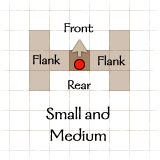 |
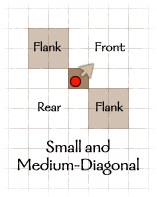 |
 |
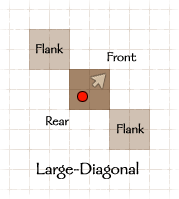 |
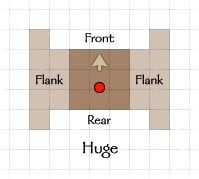 |
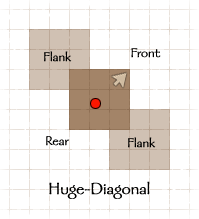 |
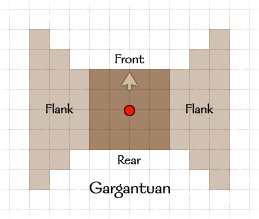 |
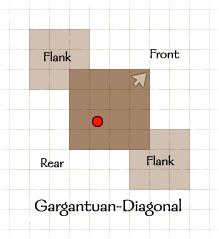 |
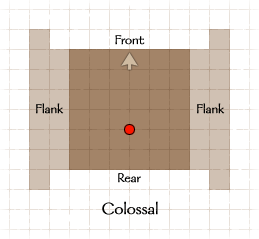 |
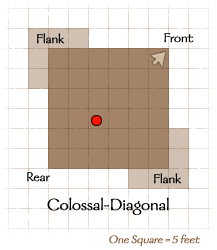 |
REVESTIMIENTO Y MOVIMIENTO
Facing has some significant effects on movement.Cambiar el revestimiento: As you move, you can freely change your facing, rotating your miniature before you step into each new square. In addition, you can change facing at the end of your move. These rules do not apply if your movement is limited to a 5-foot step; see below.
Si no se mueve durante su giro, o si su movimiento está limitado a un paso de 5 pies, puede cambiar de orientación una vez, en cualquier momento durante su giro, como una acción libre. Puedes girar para mirar en cualquier dirección que desees, pero no puedes cambiar de orientación más de una vez. (También puede cambiar la orientación como un movimiento acción, sin embargo, si no está usando su acción de movimiento para hacer otra cosa).
Movimiento normal: You can move into any square in your front area at the normal movement cost. As you move, you may change your facing as you enter each new square. Make it clear which way you’re facing as you move, if it matters (such as when enemies are near), and set your miniature’s facing when you’re done moving. (If your miniature is on a square base, the corners of the base may extend beyond the miniature’s space. That’s okay, but remember that regardless of your facing, the size and shape of your space never actually changes.)
Moverse hacia atrás o hacia los lados: In general, you’ll usually turn your character in the direction of movement before making a move. (As described above, you may freely make such changes in facing during movement.) However, sometimes you’ll want to move without changing your facing, to avoid exposing your flank or rear area to an attack of opportunity while you move. It costs two squares of movement to enter a square on your flank or in your rear area.
Pasos de 5 pies: When taking a 5-foot step, you can move into any adjacent square, even squares in your rear or on your flank.
You do not change facing when taking a 5-foot step. (You may, however, change your facing once as a free action; see Cambio de revestimiento, arriba.)
ATAQUES DE OPORTUNIDAD
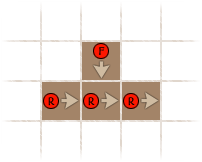
When the rogue moves out past the fighter, she provokes an attack of opportunity. Because the fighter is in her flank area, he gets a +2 bonus on the Tirada de ataque. |
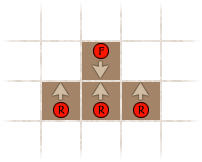
El pícaro puede moverse lateralmente más allá del luchador sin mirar en la dirección en la que se mueve, pero le cuesta dos casillas de movimiento entrar en cada una cuadrado. El luchador todavía recibe un ataque de oportunidad, pero no obtiene la bonificación de +2 porque está parado en el frente del pícaro área. |
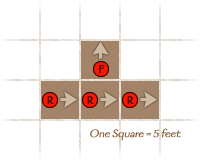
Si el pícaro se mueve por la espalda del luchador, aún puede hacer un ataque de oportunidad, pero con una penalización de -10 porque el pícaro está en el zona trasera del caza. El luchador también obtiene una bonificación de +2 porque está en el área de flanco del pícaro cuando ataca. |
ENFRENTAR Y ATACAR
In general, a character can attack into any square in his front area without penalty. This means that a character making a full attack should consider carefully when he takes his free action to change his facing. For example, if 6th-level Kroh is beset by a coco in his front area and a goblin in his rear area, he can attack the bugbear, take his free action to change facing towards the goblin, then attack the goblin. But he can’t then change his facing again. He’s stuck with his back to the bugbear, which is in his rear area.Los personajes que no quieran cambiar su orientación para apuntar hacia un enemigo pueden atacar en sus áreas de flanco con una penalización de -5 y en su retaguardia áreas con una penalización de -10.
Los personajes pueden realizar ataques a distancia en cualquier casilla más allá de su área frontal sin penalización, como se muestra en el diagrama adjunto. Las sanciones para realizar ataques a distancia en las áreas de flanco y retaguardia son los mismos que para el combate cuerpo a cuerpo.
Oponente que se enfrenta
Not only does your facing matter when you’re attacking, but the facing of your opponent does as well. If you’re attacking from a foe’s flank area (or the squares beyond it, if you have a reach or ranged weapon), you get a +2 bonus on the attack roll. You don’t need anyone opposite you on the other side of your foe. If you’re attacking from a foe’s rear area (or the squares beyond it), you get a +4 bonus on the attack roll.Ataques furtivos
A rogue can strike for sneak attack damage whenever her foe is flat-footed or whenever she’s attacking with a melee weapon from the foe’s rear area. She doesn’t need anyone directly opposite her to get the extra damage. The standard rules for creatures’ immunity to sneak attack still apply. For example, a Montículo tambaleante has a rear area, but it’s immune to sneak attack damage because it’s a plant. Conversely, a phasm doesn’t have a front or rear, but you can still deal extra sneak attack damage if you catch it flat-footed.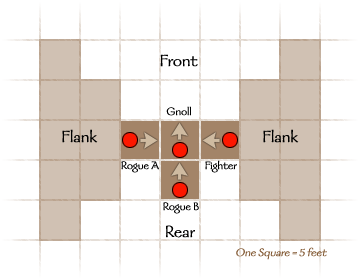
Rogue A doesn’t get to make sneak attacks against the gnoll, despite the presence of the fighter on the other side of the foe. But both the
fighter and rogue A get a +2 bonus on their attacks because they’re standing in the gnoll’s flank area.
El pícaro B puede hacer ataques furtivos contra el gnoll siempre y cuando esté atacando desde una de las casillas traseras del gnoll. Si el gnoll se vuelve para enfrentarse a Rogue B, tendrá que moverse si quiere hacer ataques furtivos.
AFRONTAMIENTO Y PERCEPCIÓN
It’s much easier to see what’s going on in your front area, and much easier to sneak around behind someone’s back.Controles puntuales: Characters take a -5 penalty on Mancha checks to perceive things in their flank area (or beyond) and a -10 penalty on Spot checks in their rear area (or beyond). The Conciencia de combate feat eliminates this penalty. Faceless creatures (ver más abajo) y las criaturas con capacidad de visión completa no reciben esta penalización.
Acciones preparadas: You can’t ready an action to respond to a trigger that occurs in your rear area if you have to see it happen (such as a doorknob turning). But you can ready an action for a sound-based trigger (such as the click of latch opening).
OTRAS CONSIDERACIONES
The facing variant requires several other rule changes.Criaturas sin rostro
Some creatures have no real facing because they can move, attack, and perceive foes equally well in every direction. All Elementales and Rezuma are faceless. Also, the following monsters are faceless: linterna arconte, Vid asesina, Bestia del Caos, Manto Oscuro, Hongo violeta, balbuceando bocas, remedar, FASM, fuego fatuo, Xorn, and pulpo (including giant octopus).Las criaturas sin rostro pueden moverse o atacar en cualquier casilla adyacente, y no pueden ser flanqueadas o atacadas por la retaguardia porque no lo hacen tienen flancos o retaguardias.
Criaturas cada vez más pequeñas
Tiny and smaller creatures don’t have facing. They can move or attack in any direction and are otherwise treated as faceless.Hazañas y características de clase
Some feats and class features provide an additional facing-related benefit to characters who have them. Also, the Conciencia de combate feat affects a character’s awareness to his flanks and rear.Hendidura y gran hendidura: The extra attacks granted by these feats can be made into flank areas without penalty, as well as into front areas.
Reflejos de combate: Characters with this feat can make attacks of opportunity into their flank areas without penalty.
Esquiva extraña mejorada: No attacker gets the +2 bonus for attacking into your flank or the +4 bonus from attack from behind you. Only a rogue four levels higher than you can deal sneak attack damage by attacking from a rear square.
Combate montado: Characters with this feat can attack into their steeds’ flank areas without penalty while mounted.
Ataque de torbellino: Characters with this feat can attack into any area without penalty.
Lanzamiento de hechizos
Spells and spell-like abilities that have areas such as lines and cones emerge from any grid intersection between the spellcaster’s space and his front area. A spellcaster can’t target anything in his rear area with a spell.Ataques de flanco
Some monsters have attacks and abilities that reach flank squares as well as front squares. These creatures take no penalty for making these attacks into flank squares.| Diablo, demonio del pozo: | Alas. |
|---|---|
| Dragón: | Alas. |
| Aullador: | Plumas. |
| Hidra: | Mordeduras. |
| Kraken: | Tentáculos. |
| Otyugh: | Tentáculos. |
| Roper: | Filamentos. |
| Calamar, Gigante: | Tentáculos. |
| Escorpión, monstruoso: | Picadura. |
Ataques por la retaguardia
Some monsters have attacks and abilities that emerge from or attack into rear squares, not front squares. These creatures take no penalty for making these attacks into rear squares.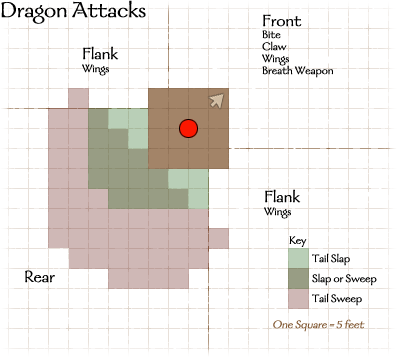
| Aranea: | Telaraña. |
|---|---|
| Halcón flechado: | Rayo eléctrico. |
| Capa: | Golpe de cola. |
| Demonio, Bebilith: | Telaraña. |
| Demonio, Marilith: | Golpe de cola. |
| Diablo, demonio del pozo: | Golpe de cola. |
| Dragón (any): | Golpe de cola o barrido de cola (ver el diagrama de Ataques de Dragón). |
| Formiano (any): | Picadura. |
| Lillend: | Golpe de cola. |
| Mantícora: | Espigas. |
| Naga, Oscuro: | Picadura. |
| Rast: | Golpe de cola, toque de cola. |
| Salamandra: | Golpe de cola. |
| Tarrasque: | Golpe de cola. |
| Guiverno: | Picadura. |
| Cocodrilo: | Golpe de cola. |
| Ballena, barbas: | Golpe de cola. |
| Ballena, Chacalot: | Golpe de cola. |
| Abeja, Gigante: | Picadura. |
| Avispa, Gigante: | Picadura. |
Escudos (opcional)
If you’re particularly keen on facing, you can add another layer of realism by modeling how shields only protect against attacks from some directions. This "variant to a variant" system introduces a shieldless AC for a character who is attacked from a direction where he can’t interpose the shield between himself and the threat. Shieldless AC is easy to figure: Just subtract the AC bonus the shield provides (including its enhancement bonus if it’s a magic shield) from the character’s normal AC.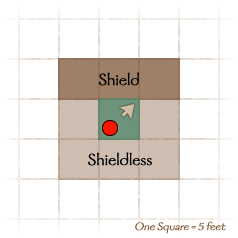
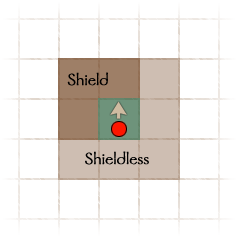
Un personaje que sostiene un escudo debe indicar si lo está empuñando hacia la izquierda o hacia la derecha. El escudo solo se suma a la CA del personaje contra ataques provenientes de su área frontal y el área de flanco en el lado del escudo, además de cualquier casilla que se encuentre más allá de esas áreas.
The escudo spell provides a bonus to AC against attacks from the front area only.
Conciencia de combate [General]
You are so perceptive that you practically have eyes in the back of your head.Beneficio: You take no -5 penalty on Mancha checks to notice things in or beyond your flank areas. The penalty to notice things in or beyond your rear area is -5.
Normal: The penalty on Spot checks in or beyond your flank areas is -5; on Spot checks in your rear area, it’s -10.
Especial: A fighter may select Combat Awareness as one of his fighter bonus feats.
REJILLA HEXAGONAL
La principal ventaja de esta variante es que elimina la regla de "cada dos cuadrados cuenta el doble" para el movimiento diagonal, ya que Elimina el movimiento diagonal. Los personajes simplemente se mueven de un hexágono a otro adyacente, cambiando de dirección a su gusto. Para determinar la distancia entre dos hexágonos, simplemente cuente los hexágonos por el camino más corto (en la mayoría de los casos, habrá un número de caminos igualmente cortos).
El uso de una cuadrícula basada en hexágonos cambia relativamente poco sobre el juego, pero plantea un dilema de mapeo para el DJ. La mayoría de los edificios y mazmorras se basan en Esquinas de 90 y 45 grados, por lo que la superposición de una cuadrícula basada en hexágonos en una estructura deja al GM con muchos hexágonos parciales, no todos los cuales son grandes suficiente para una criatura mediana. Use esta variante solo si se siente cómodo ajustando estos espacios parciales sobre la marcha.
Dependiendo de su tamaño, las criaturas ocupan uno o más hexágonos en la cuadrícula, como se muestra en el diagrama adjunto.
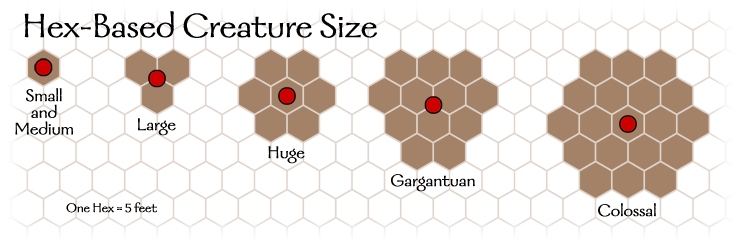
Las áreas de hechizos cambian para acomodar la cuadrícula hexagonal; Consulte el diagrama a continuación.
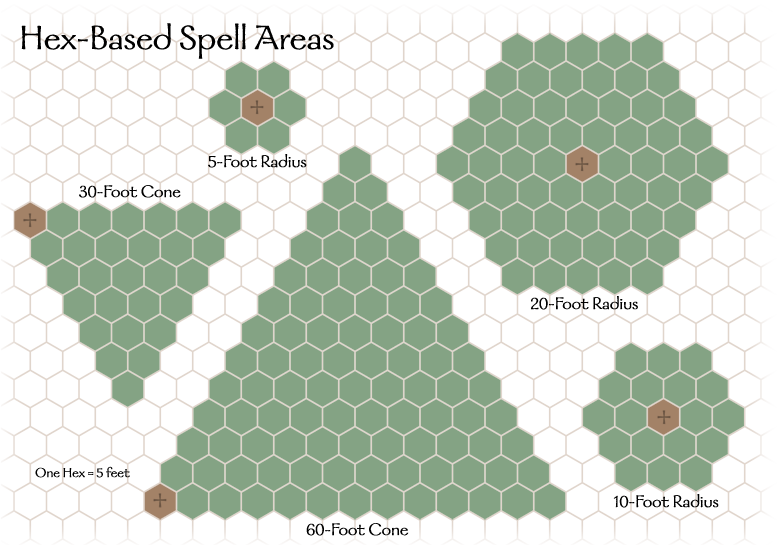
HEXÁGONOS Y REVESTIMIENTOS
The hex-grid variant works well in conjunction with the facing variant, giving your d20 game more of the feel of a tactical skirmish wargame. If this suits your gaming group, use the diagram below to determine front, flank, and rear areas according to the facing rules.